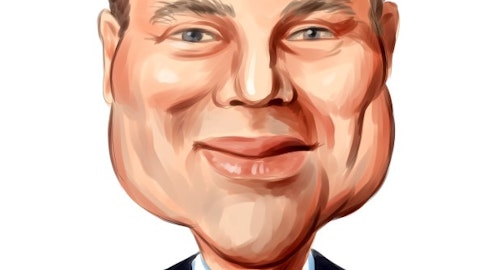Giverny Capital, an asset management firm, published its second-quarter 2021 investor letter – a copy of which can be downloaded here. A quarterly net return of 7.29% was delivered by the fund for the Q2 of 2021, slightly below its benchmark, the S&P 500 Index, which delivered an 8.5% gain for the same period. You can take a look at the fund’s top 5 holdings to have an idea about their top bets for 2021.
In the Q2 2021 investor letter of Giverny Capital, the fund mentioned CarMax, Inc. (NYSE: KMX) and discussed its stance on the firm. CarMax, Inc. is a Richmond, Virginia-based used vehicles and wholesale vehicle auction operator with a $21.9 billion market capitalization. KMX delivered a 42.92% return since the beginning of the year, while its 12-month returns are up by 28.56%. The stock closed at $135.00 per share on September 14, 2021.
Here is what Giverny Capital has to say about CarMax, Inc. in its Q2 2021 investor letter:
“We’re quite optimistic about Carmax, our second largest position. For several years, investors have gravitated to a thesis that a handful of start-ups that sell used cars in an online-only format will end up with a lower cost structure than Carmax. This even though Carmax appears today to have lower costs to buy used cars for its inventory, recondition them for resale and transport them to stores – all problems that are not solved by a good web site. Carmax also amortizes its national advertising over a much larger sales base than competitors, giving it lower marketing expense per vehicle.
Nevertheless, Carmax was slow to respond to the emerging market for online car shopping. The good news is that it ultimately responded with vigor. Over the past few years it has seen operating margins contract as it invested in an omnichannel capability that lets customers buy fully online or do a portion of the transaction online and a portion in the store. Importantly, the customer chooses exactly which parts of the transaction to complete online or in store.
Now, it may be harvesting rewards. Carmax’s most recent earnings report was eye-popping. With its omnichannel transformation complete, Carmax reported that comparable sales rose 99% (on a pandemic-depressed comparison) in its May quarter, far ahead of expectations. The two-year comparable sales increase was 16%. Profit margins expanded and Carmax even suspended a test of lower prices in select markets, which was meant to measure elasticity of demand, because it was having no trouble selling cars at higher prices.
Carmax reported that 75% of transactions in the May quarter involved a customer completing a portion of the deal online, but only 8% were completed entirely online. Customers clearly like doing some parts of a transaction online and some parts in person. Importantly, Carmax now is the country’s largest online buyer of used autos from consumers, meaning it is acquiring inventory efficiently in the channel that the start-ups ostensibly were going to dominate.
Since releasing its earnings report in late June, Carmax shares are up sharply. Yet the stock’s high-teens PE multiple remains below the S&P average for a business with outstanding growth prospects and a likely return on equity above 25% this year. The used car market, like every other market, is overheated and will cool off at some point. But we feel good about our second-largest holding.”

Photo by Dieny Portinanni on Unsplash
Based on our calculations, CarMax, Inc. (NYSE: KMX) was not able to clinch a spot in our list of the 30 Most Popular Stocks Among Hedge Funds. KMX was in 39 hedge fund portfolios at the end of the first half of 2021, compared to 46 funds in the previous quarter. CarMax, Inc. (NYSE: KMX) delivered a 13.61% return in the past 3 months.
Hedge funds’ reputation as shrewd investors has been tarnished in the last decade as their hedged returns couldn’t keep up with the unhedged returns of the market indices. Our research has shown that hedge funds’ small-cap stock picks managed to beat the market by double digits annually between 1999 and 2016, but the margin of outperformance has been declining in recent years. Nevertheless, we were still able to identify in advance a select group of hedge fund holdings that outperformed the S&P 500 ETFs by 115 percentage points since March 2017 (see the details here). We were also able to identify in advance a select group of hedge fund holdings that underperformed the market by 10 percentage points annually between 2006 and 2017. Interestingly the margin of underperformance of these stocks has been increasing in recent years. Investors who are long the market and short these stocks would have returned more than 27% annually between 2015 and 2017. We have been tracking and sharing the list of these stocks since February 2017 in our quarterly newsletter.
At Insider Monkey, we scour multiple sources to uncover the next great investment idea. For example, Federal Reserve has been creating trillions of dollars electronically to keep the interest rates near zero. We believe this will lead to inflation and boost real estate prices. So, we recommended this real estate stock to our monthly premium newsletter subscribers. We go through lists like the 10 best EV stocks to pick the next Tesla that will deliver a 10x return. Even though we recommend positions in only a tiny fraction of the companies we analyze, we check out as many stocks as we can. We read hedge fund investor letters and listen to stock pitches at hedge fund conferences. You can subscribe to our free daily newsletter on our homepage.
Disclosure: None. This article is originally published at Insider Monkey.





